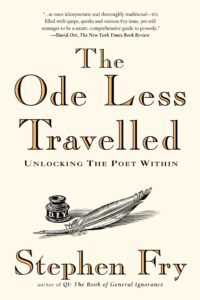Stephen Fry on Meter, Part 4
 As I mentioned previously, I’m working through Stephen Fry’s The Ode Less Travelled very slowly to absorb as much wisdom as I can about writing poetry. This week’s post covers Chapter 1, Section 4, on meters with three and four feet.
As I mentioned previously, I’m working through Stephen Fry’s The Ode Less Travelled very slowly to absorb as much wisdom as I can about writing poetry. This week’s post covers Chapter 1, Section 4, on meters with three and four feet.
Previous sections have focused on the many variants on two-footed meter, while this section is all about meters with three and four feet, most of which Fry admits are really not useful in English language poetry. The exception to this is the anapaest, a ternary rising foot, which has two unstressed syllables followed by a stressed syllable. Even within this meter, the first anapaest is often docked, which turns it into an iamb, and back to a two-footed meter.
Though the other metrical names are wild and cover basically every combination you can come up with of stressed and unstressed syllables in three and four foot phrases, they seem to be primarily useful as one-offs, rather than writing an entire poem using them as the meter. They almost entirely come from Greek, in which these meters work much more effectively.
The exercises in this chapter play with the anapaest and its opposite, the dactyl, even after Fry admits that using just dactyls is not really viable–that exercise, in particular, has the writer using dactyls and spondees, and it turned out a truly awful bit about cows (which was the prompt given in the section). The anapaest exercise was a little more useful, but much as the section suggests, most of these meters aren’t going to see wide usage in English without being hard for readers to, well, read, because they’re just so different, for the most part.

Comments